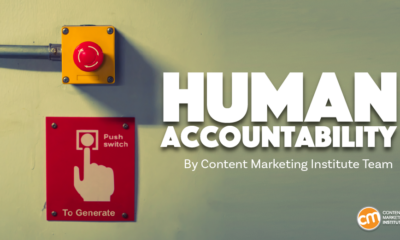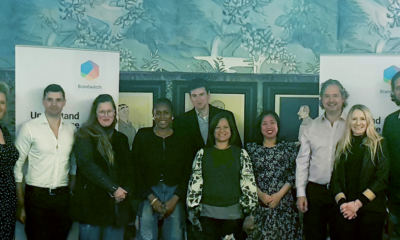MARKETING
How Planning To Fail Can Succeed [Rose-Colored Glasses]
![How Planning To Fail Can Succeed [Rose-Colored Glasses] How Planning To Fail Can Succeed [Rose-Colored Glasses]](https://articles.entireweb.com/wp-content/uploads/2022/01/1643368035_How-Planning-To-Fail-Can-Succeed-Rose-Colored-Glasses.png)
An interesting question came up recently in a marketing group I follow on social media: “What content should we create?”
The first few comments on the post were what you might suspect. Some people encouraged the poster to interview people who fit their personas to find out what they struggle with. Others talked about getting over writer’s block. A few suggested they list every question their potential customers might have and write posts about that.
The original poster responded by acknowledging the value of these responses but clarified the question. They weren’t asking what they should write that would resonate with their target audiences. They were looking for content ideas that would drive the most reactions. Full stop.
They wanted to create controversy, provocation, and a level of virality. The theory: Do something that makes a lot of noise and inspires a boatload of people to react, then the right people will pay attention to your other content that focuses on the things you do.
Predictably, the tone of the discussion shifted into a fiery debate of the flawed notion (if not ethics) of that theory. Let’s save that discussion for a different day.
But it got me thinking. Is there a case where it makes sense to deliberately put out content you don’t like, agree with, or approve of – with the explicit goal of failing?
My answer is yes.
Is there a case where you should publish #content with the explicit goal of failing? Yes, says @Robert_Rose via @CMIContent. Click To Tweet
Why intentionally failing can be a good thing
We all know failing can be a productive result. There are entire books written on how people tend to learn more from failures than successes.
But this concept almost always gets covered in the context of failing when trying to succeed. In other words, you do your level best to accomplish something – and something in that approach failed. The lesson is that you should have done something differently.
I’m interested in what happens when you deliberately try to fail or at least try something the world deems incorrect. You either confirm what you expected or get surprised by the results.
Of course, some activities lend themselves better to this approach than others. For example, I wouldn’t try to fail while learning to fly an airplane. However, in marketing – and especially content – this approach gives you an invaluable opportunity to expand your toolkit.
According to the book Brilliant Mistakes by Paul Schoemaker, advertising icon David Ogilvy made deliberate mistakes frequently. He would run ads that he and the client team had rejected just to test their collective thinking. Most would fail. But a few, including the iconic eye patch Hathaway shirt ad – would become legendary campaigns.
Think about making time, money, or content available to test your core instincts. I don’t mean running a simple A/B test to evaluate two good efforts. That only determines which one resonates better.
I’m suggesting that you try a content piece that poses an idea you flat-out rejected. Or try investing in a channel that from every angle seems to be wrong. For example, later this month, I’m going to try TikTok. I’m 99.9% sure I will fail spectacularly.
What if you invest in a channel that from every angle seems wrong? Soon, @Robert_Rose will try on #TikTok via @CMIContent. Click To Tweet
But what if I’m wrong?
There’s a famous quote attributed to IBM founder Thomas J. Watson: “If you want to increase your success rate, double your failure rate.” It seems to me there’s only one mathematical way to double your failure rate – and that’s if you occasionally deliberately try to fail.
How to fail on purpose
A friend and I had a funny saying we used to tell each other whenever we failed a test at school. We’d say, “I’d rather get a zero than a 59.”
Why? Because getting 59 means we tried and still failed.
Of course, we weren’t saying no one should ever try. We were being silly teenagers.
In content marketing, we know the value of tests and experimentation. However, most testing is done to confirm an initial assumption. In fact, a core piece of an A/B test is to form a hypothesis first. You have a suspected or proven winner, and you test an alternative version to see if it performs better.
Making a deliberate mistake is a bit different. In these are experiments, you assume you’re going to fail.
What could be the value of doing that?
Well, there can be two valuable outcomes. One is that you confirm your assumption of failure and learn something. The other is that you succeed (in other words, you fail at failing) and that long-shot effort might pay off handsomely. Even if it doesn’t, you’ve learned something.
If you make a deliberate mistake and succeed, you not only learn something, but the takeaway could pay off handsomely, says @Robert_Rose via @CMIContent. #ContentMarketing Click To Tweet
There are different flavors of deliberate mistakes. One of my favorites was made by a vice president of marketing at a big B2B company. Over the years, they had accumulated tens of thousands of subscribers to their email newsletter. Every week they would dutifully email almost 90,000 newsletters, and every week, the engagement rates were extremely low.
So, the vice president did something interesting. He sent a large segment of the subscribed but disengaged audience an email with the subject line: Sorry to See You Go.
In the body of the email, the copy told the recipient the company was sorry they’d unsubscribed from the newsletter. But, the text continued, if they thought this unsubscribe might be in error, they could respond by clicking through to a survey.
This move was clearly a deliberate mistake. Certainly most, if not all, of these subscribers wouldn’t engage with the email. But their marketing team decided it was worth making the mistake and risk losing 30,000-plus subscribers to see if they had any shot with this unengaged audience.
The result? About 60% never responded or clicked and got officially unsubscribed from the newsletter. But 40% clicked and responded, “No, this was a mistake.” They hadn’t unsubscribed. For a while, this email had the highest click-through rate.
One other surprising result? Among those who responded, about 10% indicated they were interested in subscribing to a different topic addressed by the company.
The vice president of marketing told me, “We learned a lot from that ‘mistake.’”
There are a few key moments when deliberate mistakes might make sense for your content marketing:
1. There’s less to lose
Obviously, risk plays a role in how big a mistake you should deliberately make. Skydiving, for example, isn’t the best activity where an intentional mistake is likely to pay off. You don’t want to publish a content piece completely off-brand, run afoul of legal or compliance issues, or really offend your audience. But like the vice president of marketing at that B2B company. What could they lose other than a third of the email database that wasn’t engaging anyway?
2. Rigid, institutional rules
When you intentionally make a mistake, it will more likely go your way when the mistake goes against an institutional rule or rigid, outdated convention. A great example of this is the marketing for the movie Deadpool. It was, by most counts, a campaign filled with deliberate mistakes. Perhaps the biggest was its outdoor billboard campaign with a pictogram of a skull, a poop emoji, and the letter “L” with the premiere date. Adweek called the campaign “so stupid, it’s genius.”
![How Planning To Fail Can Succeed [Rose-Colored Glasses] Billboard containing a skull, poop emoji, and letter L.](https://articles.entireweb.com/wp-content/uploads/2022/01/1643368034_184_How-Planning-To-Fail-Can-Succeed-Rose-Colored-Glasses.png)
How about that rule that says never publish blog posts on the weekend? Everybody says it doesn’t work, and publishing on those days is a mistake. Why not make that “mistake” and see what happens?
3. You are the newbie
An optimal time to make a deliberate mistake is when you’re new to a particular problem or challenge. It’s when your audience, customers, or colleagues are most likely to forgive your mistake – and then, of course, you can refer to the first moment above.
One of my good friends has been the CMO of several startup companies. He told me that when he joins a new company, he goes on a “listening tour” to hear from the practitioners. He often introduces a marketing newbie mistake into the conversation to see if a practitioner will push back, correct it, or just go with the flow. Certainly, he risks coming across as inexperienced. But, he says, what’s more important is that they start on equal footing, and he can start a dialogue with his new colleague.
Failing to fail to fail
Of course, not every deliberate mistake will end up with a successful outcome. Sometimes, after all, a mistake is a mistake – and deliberately making it will get you exactly what you asked for.
There is only one thing that’s assured: If you only fail when we’re trying not to, you may just miss out on proof you should trust your initial instincts.
Get Robert’s take on content marketing industry news in just three minutes:
Subscribe to workday or weekly CMI emails to get Rose-Colored Glasses in your inbox each week.
Cover image by Joseph Kalinowski/Content Marketing Institute

















You must be logged in to post a comment Login